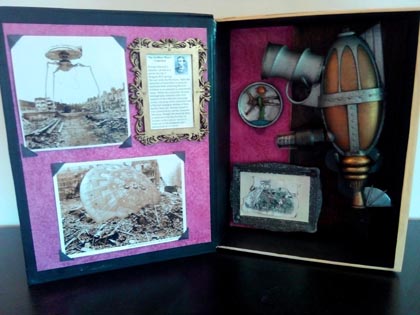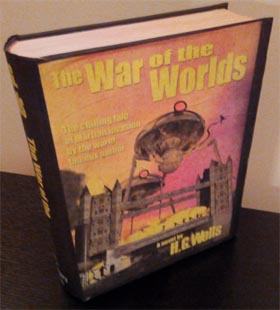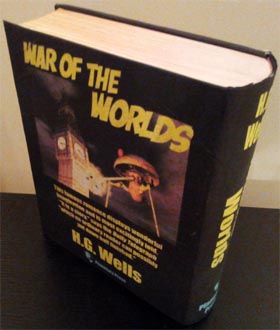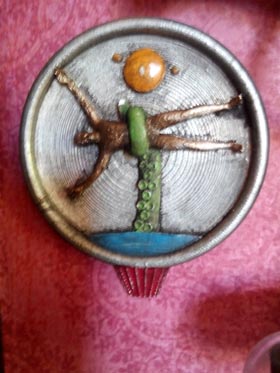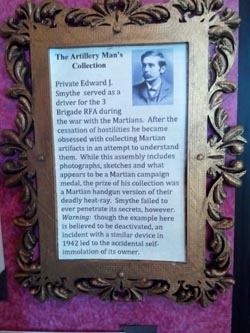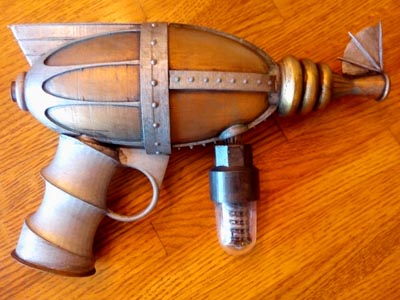pop up description layer
HOME
Cryptozoology UFO Mysteries Aviation Space & Time Dinosaurs Geology Archaeology Exploration 7 Wonders Surprising Science Troubled History Library Laboratory Attic Theater Store Index/Site Map Cyclorama
Search the Site: |
|
Notes from the Curator's Office: An
Art Project for a Favorite Novel II: War of the Worlds
Back in 2009 I created a tribute art piece to one of my favorite books, the classic 20,000 Leagues Under the Sea by Jules Verne. My idea was to create a display of objects collected by a character in the book. In the case of that 2009 project the character I chose was Professor Aronnax who narrates the story. The objects I created for that project all fit into a shadow box. They included the Professor's diary, some Photoshopped photos, notes, a map and a preserved piece of tentacle from a giant squid. These were all items related to Verne's story of three 19th century men made unwilling passengers on a then futuristic submarine, the Nautilus, by its eccentric captain, a man named Nemo. Sometime after I completed this effort I wrote about the project in my column and was contacted by gentleman in Japan who was a fan of the book interested in acquiring my creation. Having owned it and enjoyed it for a couple years I decided I was ready to part with it and use the money to create another piece of art. My new project was a similar tribute, but this time to H.G. Wells' novel War of the Worlds. I didn't want just to turn out shadow box after shadow box, however, so I looked for another form to display the art. I soon came across boxes that designed to look like oversized books and decided to purchase one and convert it to the display box for this undertaking. I really liked the concept of having the box disguised as a book and having it open to reveal not the text itself, but objects from within the story. The book/box I settled on was the largest I could find with dimensions of 13 1/2 by 11 1/2 by 3 1/4 inches.
The Cover With problem of the container solved the next challenge was to create a cover for the exterior of the book. H.G. Wells War of the Worlds was originally published in 1897 and there has been almost countless reprints in the intervening years. If you doubt it, check out Chez Zeus's site http://drzeus.best.vwh.net/wotw/wotw.html where he displays the covers for 528 of them. After examining a number of these different title images for inspiration, I decided to create an original cover for my project featuring a faux publishing company. This eliminated the possibility of any copyright infringement and allowed me the pleasure of coming up with my own interpretation for the cover. Looking at the actual covers, however, helped me select a style I liked. I wanted an image that was colorful with plenty of action. Drawing on my own work with an eComic of War of the Worlds I had illustrated in 2007, I created an image showing a pair of Martian fighting machines attacking a London icon, the Tower Bridge. The image was created using Bryce, a 3D modeling and rendering program. This image went on the front cover, while a similar image, a fighting machine next to the tower of Big Ben, was made for the rear cover, also using Bryce. The two images were composited using Photoshop along with the title and other text you might typically find on a book cover into a single large image file designed to wrap around the book. A large format poster-type printer was then used to print the cover at a size appropriate for the box. The cover was then mounted onto the box with a glue similar to wallpaper paste. Since the inside of the box was less a book and more a display case, I lined it using something similar to wallpaper that had been popular in the late 19th century when the book was first published.
The Interior What exactly to put inside the book was the next question. Some objects were obvious. The photos I had created for the 20,000 Leagues Under the Sea project had been very effective so I wanted to create similar ones for War of the Worlds. The shape of the box when opened was a large flat panel on the left hand-side and a 3 inch deep box on the right. The large flat area provided an excellent location for photographs that required little depth. Starting with historic photos of London, I used Bryce to create Martian fighting machines posed to match the pictures and composited these into the photos using Photoshop. Photoshop was also used to remove any objects from the photos that seemed inconsistent with the late 19th century era. I created four photos and chose two to mount in the project using a mounting technique appropriate for to the early 20th century. This mounting method depended on small trianglar paper corners that hold the pictures by the edges. This avoids the photograph having to be glued to something and makes them removable. A few decades ago these corners were commercially available, but are no longer produced today. With black construction paper, scissors and little careful folding, however, I was able to reproduce these, giving the photos the feeling of having been mounted on the surface many decades ago. 3D Printer
At this point, however, I reached an impasse in the project. What should the deep section of the box contain? At first I considered the tip of a mechanical tentacle from one of the fighting machines. However, a tentacle had been featured on the 20,000 Leagues Under the Sea project and I really felt wanted to do something different. Not being inspired I decided to put the project on hold for a while until I was really came up with an idea for that part of the box that resonated with what I was trying to do. At the end of 2015 my son talked me into purchasing a 3D printer. While he needed it for some engineering projects I saw it as a tool for creating art and this brought back to mind the War of the Worlds project. I'd always enjoyed science fiction movies, science fiction props and especially ray guns. It occurred to me that now owning a 3D printer would allow me to create a ray gun design of my own. Furthermore it could be the centerpiece of the War of the Worlds project. While the Martians using personal weapons isn't mentioned in H.G. Wells book, it is logical that they might carry sidearms that were miniature versions of the destructive "heat ray" mounted on their fighting machines. My design for the ray gun had some caveats. First, it had to fit into the available space in the box. Second it should be immediately recognizable to the casual observer as a ray gun. Finally there should be some consideration to the idea that the weapon was an alien device, not human produced. The great thing about using a 3D printer is that what you can make, for the most part, is only limited by what your mind can conceive. After visualizing the design in my head I used the Byrce 3D design software to create the object on my desktop computer. It looks much like a traditional ray gun with art deco influences. Because it is Martian and not terrestrial it is slightly bigger than a hand gun and its grip is not meant to be held by human hands, but by a tentacle that wraps around the it. Where the magazine might be found on some traditional pistols (like the Mauser C96), just forward of the grip, the ray gun had a detachable object that looks at bit like an old radio tube. The idea is that the tube would be charged up with energy for the gun and could be replaced with a new tube when exhausted.
As the bed size of my 3D printer was not extremely large, the gun was designed in 6 pieces and assembled later on. This made painting and the removal of any supports necessary during printing process easier as the supports could be put on a unfinished surface meant to interface with other parts of the gun. In addition to the gun a "Martian Campaign Metal" was also designed and printed on the 3D printer This object was an insignia worn by Martians to indicate they are veterans of the Conquest of Earth campaign and shows a Martian tentacle gripping a helpless human form. I also included a sketch made by a reporter at one of the Martian battles. Story The final element of the display is a 3D printed frame with some explanation of the work: The Artillery Man's Collection Private Edward J. Smythe served as a driver for the 3 Brigade RFA during the war with the Martians. After the cessation of hostilities he became obsessed with collecting Martian artifacts in an attempt to understand them. While this assembly includes photographs, sketches and what appears to be a Martian campaign medal, the prize of his collection was a Martian handgun version of their deadly heat-ray. Smythe failed to ever penetrate its secrets, however. Warning: though the example here is believed to be deactivated, an incident with a similar device in 1942 led to the accidental self-immolation of its owner. I tried to give the explanation of the work a bit of dark humor. The artillery man is actually a character in the book. He's never named, however, so I had to invent a name -- Edward Smythe -- for him. Overall I'm very happy with the piece and the freedom that the 3D printer gives me to create almost any object I need. I'm sure it will be a tool I will use in my next classic novel art piece.
Copyright 2016 Lee Krystek. All Rights Reserved. |
|
Related Links |
|
|



